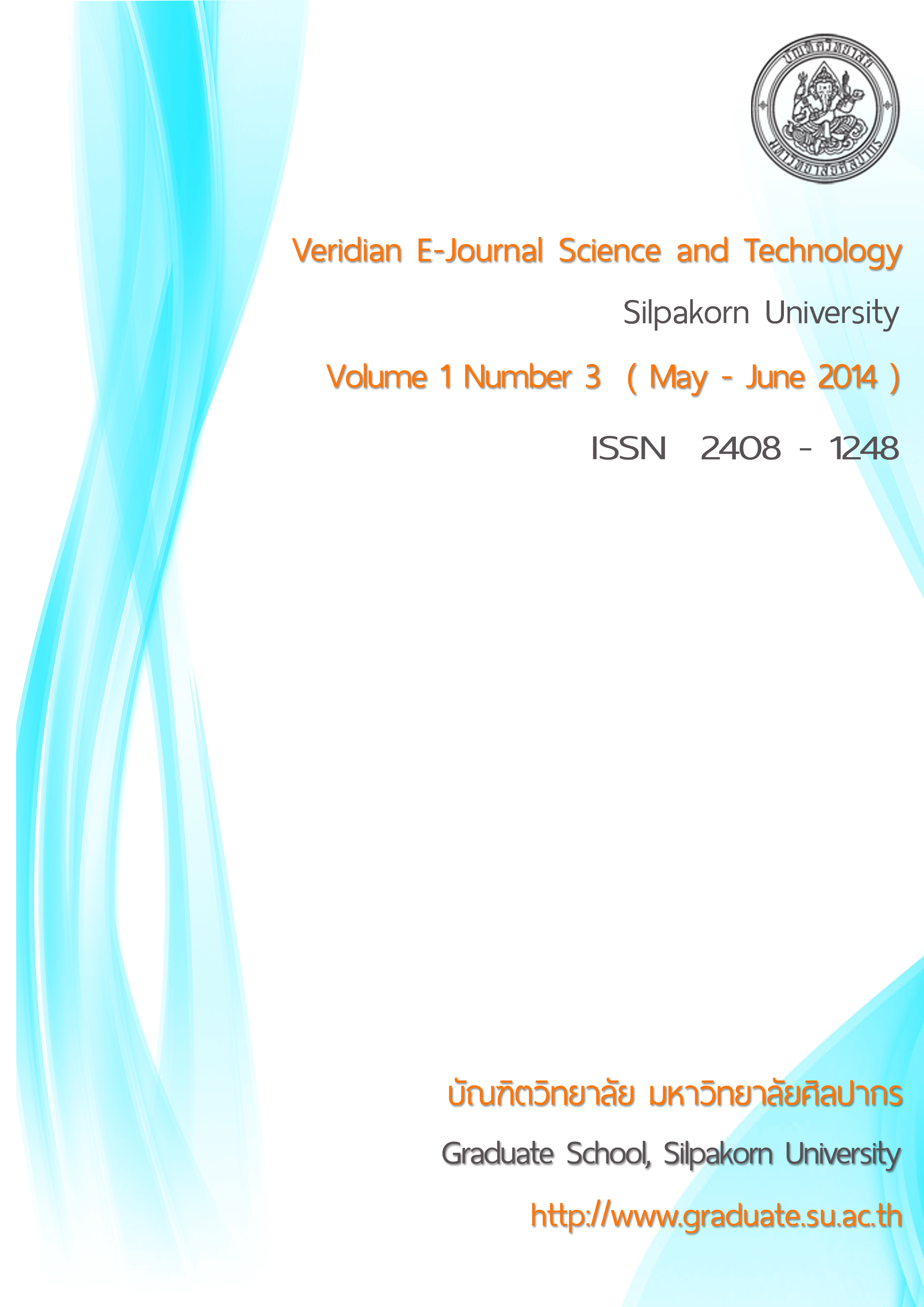ภูมิคุ้มกันต่อไวรัสอหิวาต์สุกรในสุกรที่ได้รับวัคซีนสายพันธ์ซีชนิดเพาะเลี้ยงในเนื้อเยื่อ และสุกรที่ได้รับวัคซีนสายพันธุ์ซีชนิดเพาะเลี้ยงในกระต่าย
Main Article Content
Abstract
บทคัดย่อ
โรคอหิวาต์สุกร มีสาเหตุเกิดจากเชื้อไวรัสอหิวาต์สุกร (classical swine fever virus, CSFV) จีนัส Pestivirus วงศ์ Flaviviridae เป็นโรคติดต่อในสุกรส่งผลกระทบต่อปัญหาเศรษฐกิจทั่วโลก วัตถุประสงค์ เพื่อศึกษา ระบบภูมิคุ้มกันแบบสารน้ำและระบบภูมิคุ้มกันแบบพึ่งเซลล์ ในสุกรกลุ่มฉีดวัคซีน tissue cultured C-strain และสุกรกลุ่มฉีดวัคซีน lapinised C-strain หลังฉีดวัคซีน 3 วัน และฉีดเชื้อพิษทับด้วยเชื้อ CSFV ชนิดรุนแรงมากสายพันธุ์บางเขน ผลการทดลองพบว่า สุกรกลุ่มฉีดวัคซีน tissue cultured C-strain มีอุณหภูมิร่างกายสูงขึ้นเฉลี่ยระหว่าง 39.40±0.26°ซ. - 39.95±0.70°ซ. ในขณะที่สุกรกลุ่มฉีดวัคซีน lapinised C-strain มีอุณหภูมิร่างกายสูงขึ้นเฉลี่ยระหว่าง 39.25±0.34°ซ.- 39.58±0.13°ซ. สุกรกลุ่มฉีดวัคซีน tissue cultured C-strain จำนวน 3 ใน 4 ตัว ไม่มีการลดลงของจำนวนเม็ดเลือดขาวและการแสดงออกของยีน TGF-b แต่มีการเพิ่มขึ้นของยีน IFN-g ในวันที่ 3 หลังฉีดเชื้อพิษทับ สุกรจำนวน 3 ใน 4 ตัว ในกลุ่มนี้กระตุ้นแอนติบอดีในวันที่ 14 และ 21 และไม่แสดงอาการป่วยรุนแรงหรือตายหลังฉีดเชื้อพิษทับ อย่างไรก็ตาม สุกรจำนวน 1 ตัว ซึ่งฉีดวัคซีน tissue cultured C-strain มีจำนวนเม็ดเลือดขาวและยีน TGF-b ลดลง แต่ไม่มีการเพิ่มขึ้นของยีน IFN-g ตรวจพบแอนติบอดีในวันที่ 14 และตรวจพบแอนติเจนในวันที่ 5, 7 และ 14 หลังฉีดเชื้อพิษทับ โดยสุกรแสดงอาการป่วยรุนแรงและตายในวันที่ 18 หลังฉีดเชื้อพิษทับ เช่นเดียวกันกับสุกรในกลุ่มควบคุมบวก สุกรทั้งสี่ตัวในกลุ่มฉีดวัคซีน lapinised C-strain ไม่มีการลดลงของจำนวนเม็ดเลือดขาวและยีน TGF-b แต่มีการเพิ่มขึ้นของยีน IFN-g ในวันที่ 3 หลังฉีดเชื้อพิษทับ สุกรทั้งสี่ตัวในกลุ่มนี้กระตุ้นแอนติบอดีในวันที่ 14 และ 21 และไม่แสดงอาการป่วยรุนแรงหรือตายหลังฉีดเชื้อพิษทับ อาการทางคลินิก อุณหภูมิร่างกาย จำนวนเม็ดเลือดขาว การแสดงออกของยีน IFN-g และ TGF-b รวมทั้งการตรวจพบแอนติเจนและแอนติบอดีในสุกรกลุ่มที่ได้รับวัคซีน tissue cultured C-strain จำนวน 3 ใน 4 ตัว เหมือนกันกับสุกรกลุ่มที่ได้รับวัคซีน lapinised C-strain ทั้ง 4 ตัว อย่างไรก็ตาม วัคซีน tissue cultured C-strain ให้ความคุ้มโรคต่อเชื้อ CSFV ชนิดรุนแรงมากสายพันธุ์บางเขนได้เพียงบางส่วน ในขณะที่วัคซีน lapinised C-strain ให้ความคุ้มโรคได้อย่างสมบูรณ์หลังฉีดวัคซีน 3 วัน
Abstract
Classical swine fever is caused by classical swine fever virus (CSFV), genus Pestivirus, Family Flaviviridae. It is a highly contagious disease of swine that effects to economically worldwide. The aim is to investigate humoral and cell mediated immune responses in tissue cultured C-strain vaccinated pigs and lapinised C-strain vaccinated pigs, 3 days post vaccination, and challenged with a highly virulent CSFV Bangkhen strain. In our results, tissue cultured C-strain vaccinated group had the average rising body temperature 39.40±0.26°C - 39.95±0.70°C, whereas lapinised C-strain vaccinated group had the average rising body temperature 39.25±0.34°C - 39.58±0.13°C. Three of four pigs in tissue cultured C-strain vaccinated group did not decrease white blood cells and TGF-b gene expression but increased IFN-g gene on day 3 post challenge. Three of four pigs in this group induced antibody on day 14 and 21 and did not show severe clinical signs or died post challenge. However, one pig in tissue cultured C-strain vaccinated group decreased white blood cells and TGF-b gene but did not increase IFN-g gene, the antibody was detected on day 14 and the antigen was detected on day 5, 7 and 14 post challenge. This pig showed severe clinical signs and died on day 18 post challenge, as well as pigs in positive control group. All of four pigs in lapinised C-strain vaccinated group did not decrease white blood cells and TGF-b gene but increased IFN-g gene on day 3 post-challenge. All of four pigs in this group induced antibody on day 14 and 21 and did not show severe clinical signs or died post challenge. The clinical sign, body temperature, total white blood cells, IFN-g and TGF-b gene expression, including antibody and antigen detection in three of four tissue cultured C-strain vaccinated pigs were similar to all of four lapinised C-strain vaccinated pigs. However, tissue cultured C-strain vaccine partially protected pigs while lapinised C-strain vaccine completely protected pigs against the highly virulent CSFV Bangkhen strain at 3 days post vaccination.

